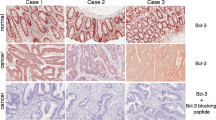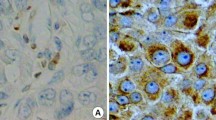Abstract
Thebcl-2 oncogene plays an important role in carcinogenesis by inhibiting cell death (apoptosis). It was initially discovered in follicular B cell lymphoma with t(14, 18), and subsequently found in other malignant and premalignant lesions. Alteration of the normal controls of cell proliferation is also a significant factor in the multistep process of tumorigenesis. The proliferative activity of a given lesion is commonly evaluated by MIB1, a monoclonal antibody to Ki67 proliferation antigen. Immunohistochemical (IHC) staining expression of bcl-2 and Ki67 was retrospectively investigated in a series of 52 colorectal carcinomas and 56 adenomas according to the avidin-biotin-complex method. The aim of the study was twofold: 1) to investigate any correlation between MIB1 and bcl-2 immunostaining expression in colonic adenomas and carcinomas, 2) to identify any relationship between either marker and several histopathologic parameters including tumor size, pathologic stage, lymph node metastasis, angiolymphatic invasion, tumor grade and differentiation in colon carcinomas. Bcl-2 was consistently higher in adenomas than in carcinomas. There were 44/56 (78.6%) adenomas, and 27/52 (51.9%) carcinomas positive for bcl-2 (p=0.004). The mean Ki67 labeling index (LI) was 30.05±7.6 and 38.12±11.01 in adenomas and carcinomas, respectively (p=0.0001). Expression of bcl-2 in carcinoma was significantly associated with a lower mean Ki67 LI and with favorable histopathologic parameters. We conclude that bcl-2 oncoprotein expression is probably an early step in the process of colon carcinogenesis, and its expression may be associated with a favorable clinical course. Furthermore, an inverse relationship exists between bcl-2 and Ki67 in colonic neoplasia. Evaluation of bcl-2 and Ki67 IHC expression in colonic carcinoma should be performed prospectively to determine if their expression is of value in predicting the clinical course in these patients.
Similar content being viewed by others
References
Lauwers GY, Kandemir O, Kulbilis P, et al. Cellular Kinitics in Barrett’s Epithelium Carcinogenic Sequence: Roles of Apoptosis, bcl-2 protein, and Cellular Proliferation. Mod Pathol 10:1201–1208, 1997.
Suster S, Fisher C, Moran CA: Expression of bcl-2 Oncoprotein in Benign and Malignant Spindle Cell Tumors of Soft Tissue, Skin, Serosal Surfaces and Gastrointestinal Tract; Am J Surg Pathol 22:863–872, 1998.
Berardo MD, Elledge RM, Moor C, et al: Bcl-2 and Apoptosis in Lymph Node Positive Breast Carcinoma. Cancer 82:1296–1302, 1998.
Kinokawa S, Akazawa K, Kinukawa N, et al: Inverse Correlation Between the Expression of bcl-2 and p53 proteins in primary Gastric Lymphoma. Hum Pathol 27:225–233, 1996.
Barreton GB, Diebold J, Christoforis G, et al: Apoptosis and Immunohistochemical bcl-2 Expression in Colorectal Adenomas and Carcinomas. Cancer 77:255–264, 1996.
Nakamura T, Nomura S, Sakai T, et al: Expression of bcl-2 Oncoprotein in Gastrointestinal and Uterine Carcinomas and their Premalignant Lesions. Hum Pathol 28:309–315, 1997.
Bosari S, Moneghini L, Graziani D, et al: bcl-2 Oncoprotein in Colorectal Hyperplastic Polyps, Adenomas, and Adenocarcinomas. Hum Pathol 26:534–540, 1995.
Palazzo JP, Kafka NJ, Grasso L, et al: The Role of p53, p21WAF1/C1PI, and bcl-2 in Radioresistent Colorectal Carcinoma. Hum Pathol 28:1189–1195, 1997.
Lu QL, Abel P, Foster C, et al: Bcl-2: Role in Epithelial Differentiation and Oncogenesis. Hum Pathol 27:102–110, 1996.
Bronner MP, Culin C, Reed JC, et al: The bcl-2 Proto-Oncogene and the Gastrointestinal Epithelial Tumor Progression Model. Am J Pathol 146:20–26, 1995.
Carr NJ, Monihan MJ, Nzeako UC, et al: Expression of Proliferative cell nuclear antigen in Hyperplastic Polyps, Adenoma and Inflammatory Cloacogenic Polyps of the Large Intestine. J Clin Pathol 48:46–52, 1995.
Porschen R, Lohe B, Hengels KJ, et al: Assessment of Cell Proliferation in Colorectal Carcinomas Using the monoclonal Antibody Ki-67. Correlation With Pathohistologic Criteria and Influence of Irradiation. Cancer 64:2501–2505, 1989.
Sahin AA, Ro JY, Brown RW, et al: Assessment of Ki67 Derived Tumor Proliferative Activity in Colorectal Adenocarcinomas. Mod Pathol 7:17–22, 1994.
Beer TW, Buchanan R, Matthews AW, et al: Prognosis in malignant Mesothelioma Related to MIB 1 Proliferative Index and Histological Subtype. Hum Pathol 29:246–251, 1998.
Shepherd NA, Richman PI, England J: Ki67 Derived Proliferative Activity in Colorectal Adenocarcinoma with Prognostic Correlation. J Pathol 155:213–219, 1988.
Suzuki H, Matsumoto K, Terabe M: Ki67 antibody labeling index in colorectal carcinoma. J Clin Gastroenterology 15:317–320, 1992.
Berenzi A, Benetti A, Bertalot G, et al: Ki67 immunohistochemical evaluation in colorectal cancer and normal colonic mucosa. Possible clinical applications. Pathologica 84:155–163, 1992.
Benetti A, Berenzi A, Grigolato P: Growth fraction of colorectal carcinoma (Ki67): a comparative study. Int J Biol Markers 7:93–96, 1992.
Lanza G Jr,Cavazzini L, Borghi L, et al: Immunohistochemical assessment of growth fractions in colorectal adenocarcinomas with monoclonal antibody Ki67. Relation to clinical and pathologic variables. Pathol Res Pract 186:608–618, 1990.
Kyzer S, Gordon PH: Determination of proliferative activity in colorectal carcinoma using monoclonal antibody Ki67. Dis Colon Rectum 40:322–325, 1997.
Johnston PG, O’Brien MJ, Dervan PA, et al: Immunohisto- chemical analysis of cell kinetic parameters in colonic adenocarcinomas, adenomas, and normal mucosa. Hum Pathol 20:696–700, 1989.
Hoang C, Polivka M, Valleur P, et al: Immunohistochemocal detection of proliferating cells in colorectal carcinomas and adenomas with the monoclonal antibody Ki67. Preliminary data. Virchows Arch A Pathol Anat Histopathol 414:423–428, 1989.
Ishida H, Irie K, Itoh T. The Prognostic significance of p53 and bcl-2 expression in lung adenocarcinoma and its correlation with Ki67 growth fraction. Cancer 80:1034–1045, 1997.
Linden MD, Ma CK, Kubus J, et al: Ki67 and proliferating cell nuclear antigen tumor proliferative indices in DNA diploid colorectal adenocarcinomas. Correlation with histopathologic characteristics and cell cycle analysis with two-color DNA flow cytometry. Am J Clin Pathol 100:206–212, 1993.
Gerdes J: Ki67 and other proliferating markers useful for immunohistological diagnostic and prognostic evaluations in human malignancies. Caner Biol 1:199–206, 1990.
Isola JJ, Helin HJ, Helle MJ, et al: Evaluation of cell proliferation in breast carcinoma. Comparison of Ki67 immunohistochemical study, DNA flow cytometric analysis, and mitotic count. Cancer 65:1180–1184, 1990.
Hitchcock CL: Ki67 staining as a means to simplify analysis of tumor cell proliferation (Editorial). Am J Clin Pathol 96:444–446, 1991.
Yang H, Hsu P, Chan S, et al: Growth Kinetics of colorectal adenoma- carcinoma sequence: An immunohistochemical study of proliferating cell nuclear antigen expression. Hum Pathol 27:1071–1076, 1996.
Watson AJ, Merritt AJ, Jones LS, et al: Evidence of reciprocity of bcl-2 and p53 expression in human colorectal adenomas and carcinomas. Br J Cancer 73:889–895, 1996.
Duenas-Gonzalez A, Abad-Hernandez M, Cruz-Hernandez JJ, et al: Analysis of bcl-2 in sporadic breast carcinoma. Cancer 80:2100–2108, 1997.
Hao XP, Ilyas M, Talbot IC: Expression of bcl-2 and p53 in the colorectal adenoma-carcinoma sequence. Pathobiology 65:140–145, 1997.
Sinicrope FA, Ruan SB, Cleary KR, et al: Bcl-2 and p53 oncoprotein expression during colorectal tumorigenesis. Cancer Res 55:237–241, 1995.
Hawkins N, Lees J, Hargrave R, et al: Pathological and genetic correlates of apoptosis in the progression of colorectal neoplasia. Tumour Biol 18:146–156, 1997.
Author information
Authors and Affiliations
Rights and permissions
About this article
Cite this article
Saleh, H.A., Jackson, H., Khatib, G. et al. Correlation of bcl-2 oncoprotein immunohistochemical expression with proliferation index and histopathologic parameters in colorectal neoplasia. Pathol. Oncol. Res. 5, 273–279 (1999). https://doi.org/10.1053/paor.1999.0231
Received:
Accepted:
Issue Date:
DOI: https://doi.org/10.1053/paor.1999.0231




